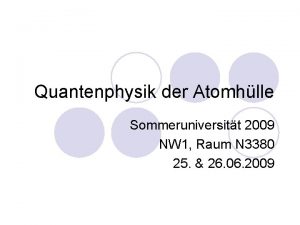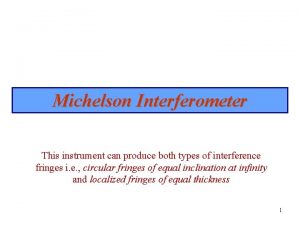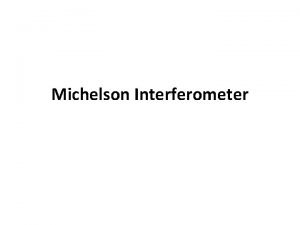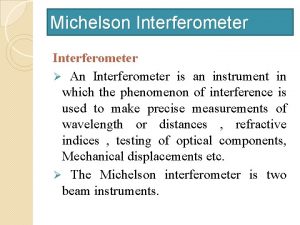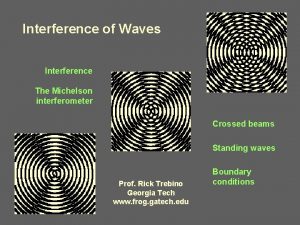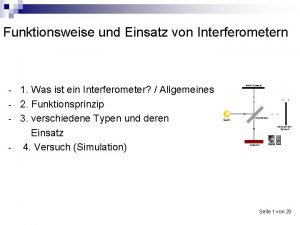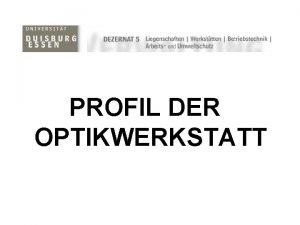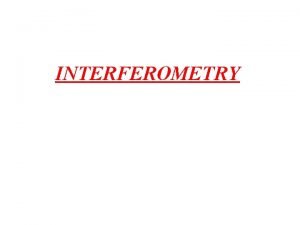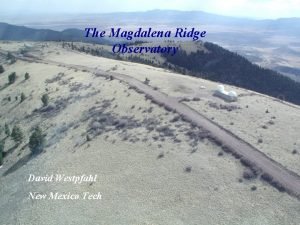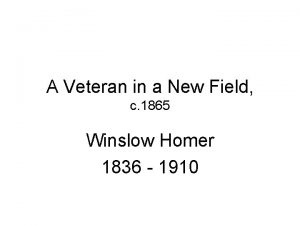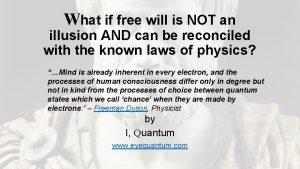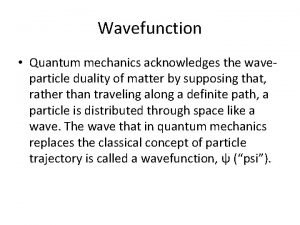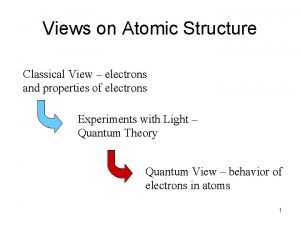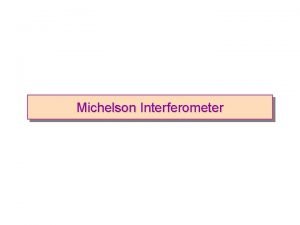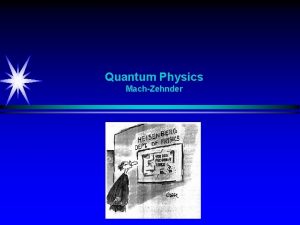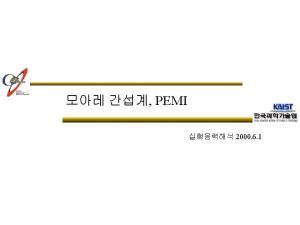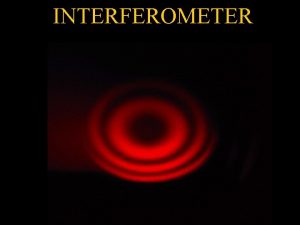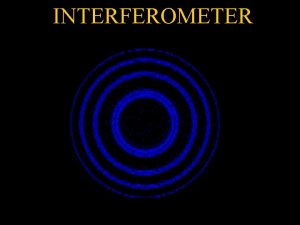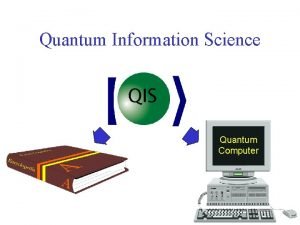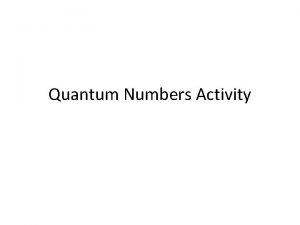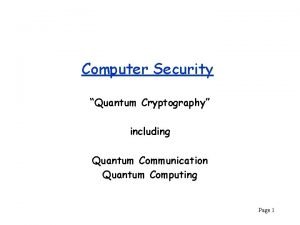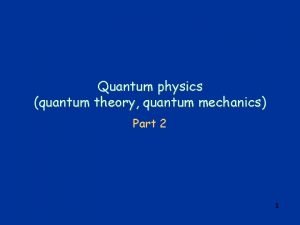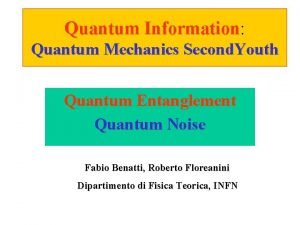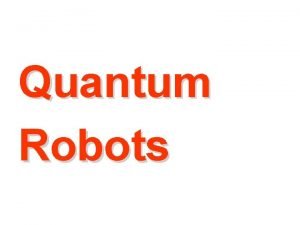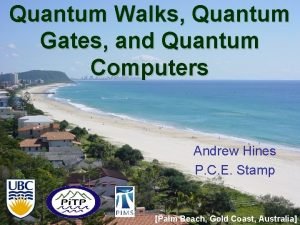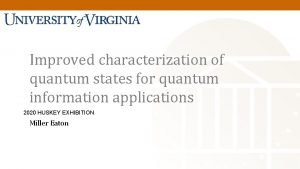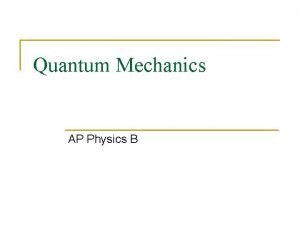Interferometer as a New Field of a Quantum


















![Displacement fluctuations induced by QRPF [m/Hz^1/2] Linear FP cavity V. Our Proposal Triangular cavity Displacement fluctuations induced by QRPF [m/Hz^1/2] Linear FP cavity V. Our Proposal Triangular cavity](https://slidetodoc.com/presentation_image/37d6ef72474269b37022360b27b66477/image-19.jpg)

















- Slides: 36

Interferometer as a New Field of a Quantum Physics - the Macroscopic Quantum System - Nobuyuki Matsumoto Tsubono lab University of Tokyo Elites Thermal Noise Workshop @ University of Jena Aug 21, 2012

Tsubono Lab @ University of Tokyo • Directed by Prof. Kimio Tsubono of department of physics at university of Tokyo • Research on Relativity, Gravitational Wave, and Laser Interferometer

motivation • Interferometer can detect gravitational waves and study quantum physics because the quantum nature of the light can move to a state of the mirror via the radiation pressure of light →Macroscopic quantum physics can be studied!

Abstract Goal Providing a new field to study quantum physics Ex. i. Studying a quantum de-coherence ii. Generation of a macroscopic “cat state” iii. Generation of a squeezed light Requirement Observation of a Quantum Radiation Pressure Fluctuations (QRPF)

Outline I. III. IV. V. VI. Introduction Effect of a radiation pressure force Radiation Pressure Interferometer Prior Research Our Proposal Summary

I. Introduction • What is the light? Wave-particle duality ↓ Uncertainty principle ΔX 1: fluctuations of the amplitude quadrature → induce a radiation pressure noise ΔX 2: fluctuations of the phase quadrature → induce a shot noise ΔX 1=ΔX 2 (vacuum state) ↓ Standard quantum limit (SQL) →ultimate limit ΔX 1 or ΔX 2 <1 (squeezed state) ↓ quantum non-demolition measurement (QND) →surpassing the SQL

I. Introduction • Quantum effect in a gravitational detector →quantum noise originated by the vacuum (ground state) fluctuations DC power + Vacuum Fluctuations (Quantum Sideband) common Laser Quantum Sideband PD differential

I. Introduction • Generation of the squeezed light & Reduction of shot noise our squeezed vacuum generator via χ(2) effect ↑ Optical Parametric Oscillator (OPO) ↓ Down conversion (green → IR) ↑ Nonlinear media (PPKTP) Seed (1064 nm) ↑ ↑ ↑ ↓ ↓ ↓ Correlated IR light ↓ Pump, Green light (532 nm)

I. Introduction • Quantum effect in an opt-mechanical system →QRPF are not noises but signals! Fixed mirror →opt-mechanical system ↓ ↓ Movable mirror ↓ ↓ → classical effect radiation pressure of light → DC power → power fluctuations →quantum effect ↓ induced by QRPF ↓ ↓ Mediation between the mechanical system and the optical system

II. Effect of a radiation pressure force • Optical spring effect Fixed mirror Spring effect PHYSICAL REVIEW A 69, 051801(R) (2004) Movable mirror

II. Effect of a radiation pressure force • Siddles-Sigg Instability (anti-spring effect) PHYSICAL REVIEW D 81, 064023 (2010)

II. Summary of the review • Opt-mechanical effects • Classical effects i. Spring effect ii. Instability iii. Cooling And so on・・・ Measured • Quantum effects i. Squeezing ii. Entanglement iii. QND And so on・・・ Not measured No one see even QRPF

III. Radiation Pressure Interferometer • Interferometer to study quantum physics using a radiation pressure effect Ø Difficulty i. Weak force light test mass low stiffness high power beam ii. Siddles-Sigg instability high stiffness low power beam configuration Technical trade-off Sensitivity vs Instability

IV. Prior Research • Suspended tiny mirror (linear FP) i. High susceptibility due to low stiffness ii. Do not have a much tolerance for restoring a high power beam • MEMS (Micro Electro Mechanical Systems) i. Light (~100 ng) but not high susceptibility due to high stiffness ii. Have a much tolerance for restoring a high power beam

IV. Prior Research • Suspended tiny mirror (linear FP) Flat mirror PHYSICAL REVIEW D 81, 064023 (2010) Φ 30 mm Width 1. 5 mm Q ~ 7. 5 e 5 C. R. Physique 12 (2011) 826– 836

IV. Prior Research • MEMS width Mass ~ 100 ng Q ~ 10^6 -10^7 PHYSICAL REVIEW A 81, 033849 (2010)

IV. Prior Research • Suspended mirror vs membrane Type Mass Resonant frequency instability Mechanical quality factor Suspended mirror ~10 mg ~1 Hz Insufficient tolerance ~7. 5 e 5 with 300 K Membrane ~100 ng ~100 k. Hz Much tolerance ~10^6~10^7 with 1 K

V. Our Proposal • Triangular cavity Siddels-Sigg instability of yaw motion is eliminated without increasing the stiffness • Silica aerogel mirror (low density ~ 0. 1 g/cm^3) More sensitive test mass
![Displacement fluctuations induced by QRPF mHz12 Linear FP cavity V Our Proposal Triangular cavity Displacement fluctuations induced by QRPF [m/Hz^1/2] Linear FP cavity V. Our Proposal Triangular cavity](https://slidetodoc.com/presentation_image/37d6ef72474269b37022360b27b66477/image-19.jpg)
Displacement fluctuations induced by QRPF [m/Hz^1/2] Linear FP cavity V. Our Proposal Triangular cavity Membrane(MEMS) SN~4 with 300 K (aerogel, m=0. 23 mg Q=300) ↓ Next, in detail SN~10 with 300 K (P_circ~1 k. W, m=2. 3 mg, Q=1 e 4) SN~10 with 300 K (P_circ~1 k. W, m=23 mg, Q=1 e 5) Can not observe with 300 K (P_circ~100 m. W, m=23 mg, Q=1 e 5) SN~2 with 1 K Frequency [Hz]

Circulating power is 800 W 20

V-I. Triangular Cavity - : align - : misalign • Triangular cavity Can use a flat mirror! mirror Angular (yaw) stability Angular (pitch) instability

V-I. Triangular Cavity • Yaw stability Reverse of the coordinate axis Demonstration of the stability. a → movable b, c → fixed ↓ Equations of motion Stability condition common differential - : align - : misalign

V-I. Triangular Cavity • Pitch instability Similar to the linear FP No reverse of the coordinate axis a → movable b, c → fixed ↓ Equations of motion Stability condition ~ 4 e-7 N m (23 mg mirror) ↑ ↓ ~ 4 e-7 N m (100 W, R=1 m, L=10 cm)

V-II. Demonstration Tungsten Φ 20 um L=2 cm Κ=1. 25 e-7 N m Resonance frequency is 365 m. Hz Flat Φ 12. 7 mm h=6. 35 mm M=1. 77 g I=2. 41 e-8 kg m^2 Round trip length ~ 10 cm Finesse ~ 250 Power gain ~ 100 Round trip loss ~ 0. 007 Mode match ~ 0. 8 Input power ~ 1 W

Sound-proofing Suspended mirror Photo-detector

Piezo mounted mirror Cylindrical Oxygen-Free Copper Φ 2× 3 Eddy current dumping Doughnut-shaped Neodymium magnet Φ 8×Φ 4× 5



V-III. Aerogel Mirror • What is the aerogel? →materials in which the typical structure of the pores and the network is largely maintained while the pore liquid of a gel is replaced by air The samples were prepared at university of Kyoto. (Inorganic Chemistry of Materials Laboratory)

V-III. Aerogel Mirror • How to make the aerogel? Supercritical drying technique ↑phase diagram Natural drying ↑Meniscus

V-III. Aerogel Mirror • Physical property Silica aerogel Silica Unit Density 3~500 2000 Kg/m^3 Poisson’s ratio 0. 17 - Young’s modulus 1 e-3~100 e-3 72. 4 GPa Coefficient of thermal expansion 4 e-6 5. 5 e-7 1/K Specific heat capacity 840 670 J/kg/K Thermal conductivity 0. 017~0. 021 1. 4 J/m/s/K Mechanical quality factor ~1000@100 g/cm^3 1 e 5 -

V-III. Aerogel Mirror • Structure a. Colloidal gel b. Polymeric gel

V-III. Aerogel Mirror • Mechanical quality factor of silica aerogel

V-III. Aerogel Mirror • How to make a good mirror? (finesse > 1000) • Polishing hydrophilic aerogel → freon or dry nitrogen gas (`slurry’ gas, it is impossible to use water) & diamond lapping film (~0. 3 um roughness) (fixed abrasive machining technique) hydrophobic aerogel → OSCAR polishing (slurry) (free abrasive machining technique) • Coating Dielectric multilayer will be prepared by ion beam sputtering

10 -11 V-III. Aerogel Mirror Q factor 2000 Q factor 300 10 -12 10 -13 10 -14 35 Physical property of aerogel ⇒ density 100 kg/m 3 , Young’s modulus 30 MPa , Q factor 300

VI. Summary • Opt-mechanical system →interesting system to study quantum physics • Triangular cavity →decrease the stiffness without being induced instability • Aerogel mirror →more sensitive mirror
 Classical mechanics
Classical mechanics Quantum physics vs quantum mechanics
Quantum physics vs quantum mechanics Mach zehnder interferometer leifi
Mach zehnder interferometer leifi Types of fringes in michelson interferometer
Types of fringes in michelson interferometer Prinsip kerja interferometer adalah
Prinsip kerja interferometer adalah What is the principle of michelson interferometer
What is the principle of michelson interferometer Michelson interferometer formula
Michelson interferometer formula Weißlichtinterferometer funktionsweise
Weißlichtinterferometer funktionsweise Interferometer oberflächenmessung
Interferometer oberflächenmessung Laser interferometer space antenna
Laser interferometer space antenna Npl flatness interferometer
Npl flatness interferometer Magdalena ridge observatory
Magdalena ridge observatory Gauss law in magnetism
Gauss law in magnetism Field dependent vs field independent
Field dependent vs field independent Field dependent vs field independent
Field dependent vs field independent Electric field and magnetic field difference
Electric field and magnetic field difference E field h field
E field h field Data types and field properties
Data types and field properties Field dependent and field independent
Field dependent and field independent Magnetic field
Magnetic field Winslow homer veteran in a new field
Winslow homer veteran in a new field Speech
Speech New york pennsylvania new jersey delaware
New york pennsylvania new jersey delaware Fresh oil, new wine scripture
Fresh oil, new wine scripture Marquee cinemas orchard 14
Marquee cinemas orchard 14 Articles of confederation strengths and weaknesses
Articles of confederation strengths and weaknesses New-old approach to creating new ventures
New-old approach to creating new ventures Marketing management chapter 1
Marketing management chapter 1 New years old is new again
New years old is new again New classical and new keynesian macroeconomics
New classical and new keynesian macroeconomics Chapter 16 toward a new heaven and a new earth
Chapter 16 toward a new heaven and a new earth Leanne keene french ambassador arrives from paris
Leanne keene french ambassador arrives from paris New classical and new keynesian macroeconomics
New classical and new keynesian macroeconomics Roosevelt wilson and taft venn diagram
Roosevelt wilson and taft venn diagram Is free will an illusion
Is free will an illusion Eigenfunction
Eigenfunction Atom jj thomson
Atom jj thomson


